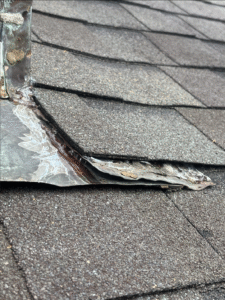Why Flashing Damage Is A Big Deal For Your Roof
Down here in Southeast Louisiana, we know how unpredictable the weather can be. From summer storms to muggy afternoons, your roof is always battling the elements. One of the biggest weak spots? Your roof’s flashing.
Flashing is that thin metal strip you see around chimneys, skylights, and where the roof meets walls. It’s there to keep water out of places it shouldn’t be. But when flashing starts to pull away, rust, or lift up, it’s a recipe for water leaks and damage.
What Does Bad Flashing Look Like?

In the photo to the right, you can see some tell-tale signs of flashing damage:
-
Metal lifting or pulling away from shingles: This creates gaps for water to sneak in.
-
Rust or corrosion: That’s a sure sign water is already finding its way in.
-
Shingles popping up: Once those shingles lose their hold, they’re not doing their job.
If you spot any of this on your roof, don’t ignore it! These little gaps can let in a lot of water, especially when those afternoon thunderstorms roll through.
Why You Should Care
Damaged flashing might seem like no big deal, but here’s what can happen:
-
Rotten wood and mold: Once water gets under the shingles, it soaks into your roof deck and can cause rot and mold.
-
Higher repair costs down the line: A small leak can turn into a big problem, fast.
-
Interior damage: Water that gets through your roof can damage your ceiling, walls, and even your floors.
What Should You Do?
If you’re seeing these signs on your roof, give us a call. At JW The Builder, we’re your neighbors—and we know how to handle these flashing issues before they turn into a full-blown leak.
We’ll inspect the area, replace any damaged flashing, and make sure your roof is ready to handle whatever the next storm brings.
Need Help? Let’s Fix It Together!
Call us today or fill out our quick online form. We’re here to keep your home dry and your mind at ease—rain or shine.
